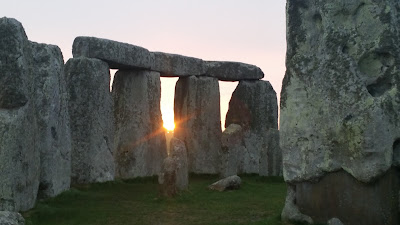English
Heritage will once again welcome people to Stonehenge to celebrate the Winter
Solstice. Sunrise is just after 8am on Wednesday 21st December and visitors
will be able to access the monument as soon as it is light enough to do so
safely. Please read the information below before planning your visit.
PRACTICAL INFORMATION:
DATE AND TIMINGSWEDNESDAY 22nd DECEMBER 2017
MONUMENT FIELD OPENS: 07.45am (approximately, depending on light levels)
MONUMENT FIELD CLOSES: 10am
MONUMENT FIELD OPENS: 07.45am (approximately, depending on light levels)
MONUMENT FIELD CLOSES: 10am
Please note, access to Stonehenge for Winter Solstice is free. Parking charges apply.
Blue Badge Parking – Blue badge parking is in the visitor centre car park and permits must be booked in advance. There is accessible transport to the monument field from the visitor centre beginning at approximately 6.30am. Permits available from Solstice.Stonehenge@english-heritage.org.uk
Parking and parking charges Limited parking is available in the winter solstice car parks, which will open at 5.30am on the 22nd December.
As you approach Stonehenge, there will be signs to direct you to the car park – please ensure that you follow these. Please do not arrive early as there is no waiting on the roads in the area and you will be moved on.
Parking may involve a shuttle journey to the visitor centre and wherever you park there may be a 30 minute walk.
- Cars, private hire minibuses and live-in vehicles £5
- Motorbikes £2
- Commercial coaches £50
The car parking charge is designed to encourage people to car share and will help the charity offset the costs of providing additional staffing and lighting in the car parks.
Please note, car parking charges apply to all users of the Winter Solstice car parks, including Blue Badge holders, and members of English Heritage and National Trust.
Motorists have access to a park and ride shuttle from the off-site solstice car parking to the visitor centre. A shuttle will also be provided between the visitor centre and Stonehenge, however visitors are asked to note that disabled people have priority on this bus and should therefore be prepared for a 30 minute walk, in low light, from parking areas to the monument.
We cannot guarantee entry to the car parks and recommend coming by public transport as cars will be turned away when the car parks are full.
CONDITIONS OF ENTRY
Access to Stonehenge for solstice is subject to the Conditions of Entry – please read these before deciding whether to attend.
COME PREPARED
Stonehenge is in a field on Salisbury Plain and the weather in December will be cold and may be wet and windy. Even if it isn’t raining, the ground will be wet from the dew. There may also be frost.
Please be prepared for a 30 minute walk (in low light or darkness), from the bus drop off and from parking areas to the monument. You are strongly advised to wear warm and waterproof clothing and footwear and bring a torch with you.
Toilets at the Monument Field will only be available once the access period begins. There are no catering facilities in the monument field, however the café at the visitor centre is open for hot drinks and breakfast rolls from 6am.
Please note that there are no other amenities or facilities available to visitors until the Monument Field opens.
Please visit the official English Heritage website for full details.
Stonehenge Guided Tours are offering their usual small group Winter Solstice guided tour from London and Bath, ideal if you do not have your own transport and want to learn more about the history and mystery of Stonehenge and the surrounding landscape. Visit their website to book.
The Stonehenge Tourist Guide









